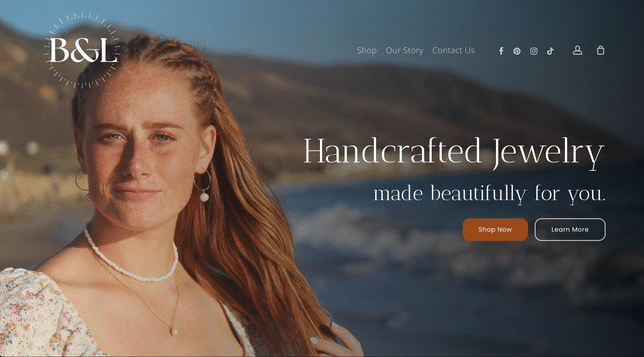You know your small business needs a website, the next big question is: how do you actually build it?
Maybe you’re just getting started, or maybe it’s time to level up from a link-in-bio and social media posts. Do you go the DIY route with a drag-and-drop builder? Or invest in a professionally designed site that’s built to grow with your business?
The truth is, every option has their place. This guide walks you through the pros and cons of some of the most common small business website options, including a middle-ground option you may not have considered, so you can choose what’s best for where your business is right now.
Option 1: Fully Custom-Coded Website
Most Expensive
Bringing in a professional to design your website can feel like a big step—but for many small businesses, it’s one of the smartest investments they’ll make.
When you work with a designer (or an agency), you’re not just getting a pretty website. You’re getting a fully custom site that’s tailored to your brand, your goals, and your customers. A professional will also consider the structure and flow of the site—making sure it’s intuitive, easy to navigate, and built around how your users actually think and behave. Professional designers understand how to build user-friendly websites that don’t just look good—they guide visitors toward action, whether that’s booking a service, making a purchase, or reaching out for more info.
A good designer also thinks ahead. Your site will be built with flexibility in mind, making it easier to evolve as your business grows. Many professionals also incorporate foundational SEO best practices and use tools or licenses that aren’t available in DIY platforms.
The Upside:
-
Tailored design: Your site is built from the ground up to match your business—not just adapted from a template.
-
Better functionality: Custom sites can include advanced features that support specific business needs.
-
SEO-friendly: Designers often implement smart structure and metadata setups that support visibility in search engines.
-
More control: You’re not tied to a one-size-fits-all platform, which means more freedom as your business grows.
The Trade-Off:
-
Cost: A fully custom-built website can range from $1,000 to $50,000+, depending on complexity, features, and the designer you choose.
-
Finding the right fit: It’s important to choose someone who understands your industry and can translate your vision into a digital experience that works.
-
Not always necessary: Most businesses don’t need a completely custom-coded site. Unless your brand requires very specific features, integrations, or styling, a well-built hybrid solution can often offer everything you need at a more manageable price point.
Is This Right for You?
A fully custom website is a great fit if your business needs highly specialized features, unique styling, or advanced functionality that simply can’t be achieved with off-the-shelf templates or DIY platforms. It’s also ideal if you want full control over how your site is built, how it performs, and how it scales over time.
If your brand experience is central to how you attract and serve customers—and you have the budget to invest—custom design gives you the freedom and flexibility to build exactly what you need, with no compromises.
Option 2: Using DIY Template Builders
Least Expensive
If you’re just getting your business off the ground or trying to keep costs low, DIY website builders can feel like the obvious choice—and for good reason. Platforms like Wix, Squarespace, and Shopify offer sleek templates, simple drag-and-drop interfaces, and all-in-one plans that make getting online fast and fairly painless.
With just a little time and patience, you can launch a decent-looking website without touching a single line of code. For many startups and solo entrepreneurs, that’s a huge win.
The Upside:
-
Affordable web design: These platforms are often subscription-based, with predictable monthly costs that fit most startup budgets.
-
Beginner-friendly: No coding required. You can choose a template, add your content, and hit publish.
-
Quick setup: Many businesses can go from idea to live site in just a day or two.
-
Built-in tools: Hosting, basic SEO, and even e-commerce tools are usually baked right in.
The Trade-Off:
-
Limited customization: You’re working within a set framework. That can make it hard to create something that truly stands out or reflects your unique brand.
-
Scalability concerns: As your business grows, you may find yourself bumping into platform limits—whether it’s with design flexibility, advanced features, or integrations.
-
Ongoing platform restrictions: Many DIY builders restrict access to certain tools, plugins, or performance enhancements unless you upgrade (or switch platforms entirely).
Is This Right for You?
Website design for startups often starts here—and that’s okay. If your goal is simply to have a clean, professional online presence and your needs are basic, a DIY builder might be just right for now.
But if you know you’ll need more advanced features later (like a larger store, deeper analytics, or more control over SEO), it’s worth thinking ahead. Sometimes what saves money now can cost more down the road if you end up needing a full rebuild to support your growth.
Option 3: Hybrid Solution
Most Flexible
If you’re stuck somewhere between “I want it to look professional” and “I need to stay on budget,” there’s good news—you don’t always have to choose one extreme or the other. There’s a middle ground that offers flexibility, affordability, and a professional look: hybrid website solutions.
This approach often combines a DIY-style foundation (like a premium WordPress theme) with light professional support. For example, you might purchase a high-quality template and then hire a designer to customize the layout, integrate your branding, and help you launch with confidence. Or you might work with a consultant who helps set up your site and teaches you how to manage it yourself moving forward.
While a hybrid site may not offer the extremely advanced level of functionality or advanced features as a fully custom-coded website, it gives you far more flexibility than platforms like Wix, Squarespace, or Shopify. And many of the perks that come with a custom site—like a thoughtful SEO foundation, strategic layout, and a professionally polished design—can still be part of the package.
The Upside:
-
Budget-friendly with a professional edge: You save on the full custom price tag while still getting expert input where it matters most.
-
Faster turnaround: You’re building on a strong starting point, which cuts down the time from concept to launch.
-
More flexibility than DIY: Hybrid solutions offer far more control and customization options than basic site builders.
-
Room to grow: Starting with WordPress gives you the ability to scale and evolve your site as your business grows. And you can always add custom code to it later to expand the functionality and styling options that you may not need right off.
The Trade-Off:
-
Some limitations still apply: While hybrid sites offer more flexibility than DIY builders, they may not support the most advanced custom features or highly complex functionality.
-
Still requires some hands-on work: You’ll likely still be involved in content creation, image selection, and minor edits—especially if you’re managing the site after launch.
-
Not fully custom: Your site will still be built on a pre-existing framework or template, which means some design or structural limitations may remain compared to a ground-up custom build, but you can always add custom code later to extend your site further.
Is This Right for You?
If your budget is tight but you want something more tailored than a basic DIY builder can offer, a hybrid approach might be the perfect fit. It’s especially helpful for business owners who are willing to roll up their sleeves but want to avoid the trial-and-error phase that often comes with building entirely alone.
Real-World Examples
Two of our recent clients, Brook & Lane Jewelry and Salt Lake Scents, started small but knew they needed something more scalable than marketplace platforms like Etsy. They didn’t need a fully custom-coded site—but they did need something professional, flexible, and built with growth in mind. Their hybrid websites gave them more control over their branding and e-commerce experience without the high fees or limitations of third-party platforms.

How to Decide What’s Right for Your Business?
There’s no one-size-fits-all answer when it comes to building your website—just the solution that fits you best right now.
Start by asking yourself a few key questions:
- What’s my current budget?
If you’re just starting out and cash is tight, a DIY builder or hybrid option might make more sense for now. But if you have a healthy budget and your business requires more advanced or unique customization, investing in a fully custom site could be a smart move.
-
How much time can I realistically spend on this?
DIY platforms are convenient, but they still take time to learn and set up. If you’re short on hours or already wearing too many hats, hiring a professional (or at least getting some support) can save you major headaches.
- What features do I need now—and in the future?
Will you be selling products online? Do you want to expand later with things like booking tools, directories, or advanced analytics? Thinking through those needs now can help you avoid rebuilding later.
- How important is standing out online?
If your website is a key part of how clients find and choose you, design and functionality matter. A cookie-cutter site might work in the short term, but it may not reflect the quality or uniqueness of your brand.
There’s nothing wrong with starting small and simple—as long as you choose an option that can grow with you when the time comes.
Conclusion
No matter which route you choose—DIY, hybrid, or fully custom—investing in your website is a smart move for your business. Your site is often the first impression people get of your brand, and having a space that looks professional, functions well, and reflects who you are makes a real difference.
The best choice isn’t about what everyone else is doing—it’s about what works for you. Your budget, your goals, your timeline, and your comfort level with tech all play a part. Whether you’re building your first site or looking to upgrade what you’ve already got, just remember: you don’t have to do it alone, and you don’t have to do it all at once.
Thinking the Hybrid option might be right for your business?
Reach out to our team for a free consultation to see how we can help you grow with a site that works for you today—and scales with you tomorrow.

